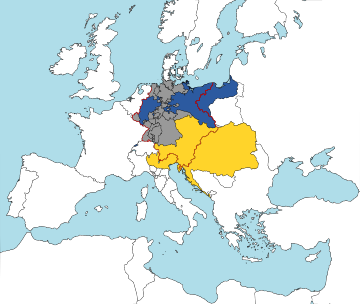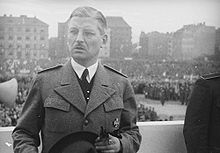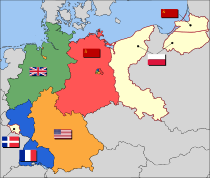German question

Caption reads: "German Unity. A Tragedy in one Act."
The "German question" was a debate in the 19th century, especially during the
The solutions are also referred to by the names of the states they proposed to create, Kleindeutschland and Großdeutschland ("
During the Cold War, the term was repurposed to refer to the matters pertaining to the division, and re-unification, of Germany.[2]
Background

There is, in political geography, no Germany proper to speak of. There are Kingdoms and Grand Duchies, and Duchies and Principalities, inhabited by Germans, and each separately ruled by an independent sovereign with all the machinery of State. Yet there is a natural undercurrent tending to a national feeling and toward a union of the Germans into one great nation, ruled by one common head as a national unit.
— The New York Times, July 1, 1866[3]
Over the centuries, the loose German Holy Roman Empire had to cope with a continuous loss of authority to its constituent Imperial States. The disastrous Thirty Years' War proved especially detrimental to the Holy Roman Emperor's authority, as the mightiest two entities within it, the Austrian Habsburg monarchy and Brandenburg-Prussia, evolved into rivalling European absolute powers with territory reaching far beyond Holy Roman Imperial borders. Meanwhile, the many small city-states splintered further. In the 18th century the Holy Roman Empire consisted of over a thousand separate territories governed by distinct authorities.
This
While a number of factors swayed allegiances in the debate, the most prominent was religion. The Großdeutsche Lösung would have implied a dominant position for Catholic Austria, the largest and most powerful German state of the early 19th century. As a result, Catholics and Austria-friendly, mostly southern states usually favored Großdeutschland. A unification of Germany led by Prussia would mean the domination of the new state by the Protestant House of Hohenzollern, a more palatable option to Protestant, mostly northern German states. Another complicating factor was the Austrian Empire's inclusion of a large number of non-Germans, such as Hungarians, Czechs, South Slavs, Italians, Poles, Ruthenians, Romanians and Slovaks. Additional complication was that the Austrians were reluctant to enter a unified Germany if it meant giving up their non-German speaking territories.
March Revolution
In 1848, German liberals and nationalists united in
Those supporting the Großdeutsche position argued that since the Habsburgs had ruled the Holy Roman Empire for almost 400 years from 1440 to 1806 (the only break coming from the extinction of the Habsburg male line in 1740 to the election of

Thus, some members of the assembly, and Prussia in particular, promoted the Kleindeutsche Lösung, which excluded the whole Austrian Empire with its German and its non-German possessions. They argued that Prussia, as the only Great Power with a predominantly German-speaking population, was best qualified to lead the newly unified Germany. Yet, the drafted constitution provided for the possibility for Austria to join without its non-German possessions later. On March 30, 1849, the Frankfurt parliament offered the German Imperial crown to King Frederick William IV of Prussia, who rejected it. The revolution failed and several subsequent attempts by Prince Schwarzenberg to more closely unite the German Confederation headed by Austria came to nothing.
Austro-Prussian War and Franco-Prussian War

These efforts were finally terminated by Austria's humiliating defeat in 1866 Austro-Prussian War. After the Peace of Prague, the Prussian Minister President Otto von Bismarck, now at the helm of German politics, pursued the expulsion of Austria and managed to unite all German states except Austria under Prussian leadership, while the Habsburg lands were shaken by ethnic nationalist conflicts, only superficially resolved with the Austro-Hungarian Compromise of 1867.
At the same time, Bismarck established the North German Confederation, seeking to prevent the Austrian and Bavarian Catholics in the south from being a predominant force in a mainly Protestant Prussian Germany. He successfully used the Franco-Prussian War to convince the other German states, including the Kingdom of Bavaria, to stand with Prussia against the Second French Empire; Austria-Hungary did not participate in the war. After Prussia's speedy victory, the debate was settled in favor of the Kleindeutsche Lösung in 1871. Bismarck used the prestige gained from the victory to maintain the alliance with Bavaria and proclaimed the German Empire. Protestant Prussia became the dominant power of the new state, and Austria-Hungary was excluded, remaining a separate polity. The Lesser German solution prevailed.
Later influence


The idea of Austrian territories with a significant German-speaking population joining a Greater German state was maintained by some circles both in
In 1931, there was an attempt to create a customs union between the Weimar Republic and Austria. The move was protested by France, and bankers such as Henry Strakosch of Austria, who later became a financier of Winston Churchill. Large-volume money transfers followed, making the customs union impractical as the economic crisis deepened.
In Germany,
In 1938, Hitler's long-desired union between his birthplace, Austria, and Germany (
-
The Greater German Reich in 1943
East and West Germany and reunification

This unification lasted only until the end of
The German question was a central aspect of the origins of the Cold War. The legal and diplomatic intercourse between the Allies regarding the treatment of the German question brought forward the elements of intervention and coexistence which formed the basis for a relatively peaceful postwar international order.
Modern Germany's territory, after the reunification of East and West Germany in 1990, is closer to what the Kleindeutsche Lösung envisioned (aside from the fact that large areas of the former Prussia were no longer part of Germany) than the Großdeutsche Lösung, for Austria remains a separate country. Because of the idea's association with Nazism and rise of Austrian national identity, there are no mainstream political groups in Austria or Germany that advocate a "Greater Germany" today; those that do are often regarded as fascist and/or neo-Nazis.
See also
References
- ^ Robert D. Billinger (1991). Metternich and the German Question: States' Rights and Federal Duties, 1820–1834. University of Delaware Press.
- ISBN 9781315189031.
- PDF) The New York Times, July 1, 1866.
- ^ Archives, The National (2019-09-09). "The National Archives - Milestones to peace: The Treaty of St. Germain-en-Laye". The National Archives blog. Retrieved 2020-08-08.
- ^ "Internet History Sourcebooks". sourcebooks.fordham.edu. Retrieved 2020-08-08.
- ISBN 9783631581117. Retrieved 27 June 2014.
- ^ "Bibliography: Anschluss". www.ushmm.org. Retrieved 2020-08-08.
- ISBN 978-0-230-28332-9.

